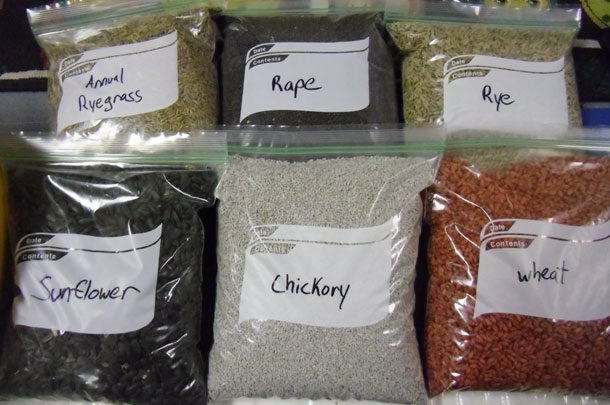The choices seem endless, but one thing has remained constant: Most producers have their favorites. Regional marketing campaigns promoting a particular variety or blend have seared that brand name into our long-term memory banks, regurgitated right about now when the seed salesman comes around.
However, as a certified crop advisor, livestock producer, and as the former poisonous plant specialist for the Pennsylvania Department of Agriculture’s noxious weed program, I view and review seed selection choices in a different light.
So before you’re done purchasing next year’s seed supply, let’s shed some light on your intentions, take a look at some selections and review any poisonous contentions.
Field conditions
Seed selection starts with a review of the intended field’s fertility status, soil type, slope and forage use. I like to start by matching varieties to soil type. For example, perennial grasses with a large rhizomatous root system do well on poorly drained soils.
Their ability to hold on fast during the heave and thaw of spring are key to their desirability. Smooth, funnel-shaped legumes don’t have enough tap root strength during their seedling year to stay in the ground when the clay particles become slick with moisture.
Stoloniferous, surface matting legumes fare much better and are more tolerant of grazing. White clover (Trifolium repens), strawberry clover (Trifolium fragiferum) and stoloniferous types of red clovers (Trifolium pretense) come to mind, as well as birdsfoot trefoil (Lotus corniculatus).
They are more persistent and tolerant of close grazing. But neither will take if the water-holding capacity of the soil can turn the field into a lake. Knowing your field’s soil type can help narrow down the choices considerably.
Slope
I doubt few producers think about slope right out of the gate when selecting a seed variety. But you could come to regret that oversight at harvest. Why? Well, plant the wrong thing and it’s all downhill from there – am I right?
Bare ground establishment of a new forage crop on the slope requires a fast emerging, quick-rooting species to prevent washout.
Warm season grasses and some of the more southern adapted broadleaf crops are not going to race out the gate in 40-degree weather. If the slope on your field makes you wish you had a rollover cage on your megaton four-wheeler, choose a quick-rooting variety that produces more root biomass than above-ground biomass in its seedling year.
Fertility
Ah, that magic word. We tend to forget that Mother Nature abhors a bare behind. If you don’t know the fertility status of your field, take a look at the weed species already on the ground. Something has to be growing there unless your herbicide mode of action hasn’t reached its half-life mark.
Most likely, you’ll find weeds like dandelion or chicory that are quite edible, even kochia. When in doubt, pick a varietal blend of a cousin or distant kin of these grazeable weed species.
It seems counterproductive to plant a species so closely related to weeds, but if your soil pH is too acidic, and your nitrogen, phosphorous, and potassium are next to nonexistent, you might plant a soil-saving cover known to be adaptive to your situation and not worry about making hay out of that fodder.
Forage use
Unless you’re a double-cropping farmer like me, you might gravitate to selecting only species that make tons of hay three or four times a year. But if that field is dual purpose, with a four-legged critter taking off one of those cuttings, it’s important to plant species that can stand up to point source compaction, liquid manure application and tolerate close cutting.
 The biting mechanism of horses differs from cows, which differs from sheep. Rip-and-tear is quite a bit more deleterious to the survivability of newly seeded plants than nip-and-nibble.
The biting mechanism of horses differs from cows, which differs from sheep. Rip-and-tear is quite a bit more deleterious to the survivability of newly seeded plants than nip-and-nibble.
Planting timing
When you will seed down is just as important as where, what, and how. Fall established cover crops are a great source of early spring grazing for many producers. Plant that same cool-season crop too late in the spring and you won’t see much biomass once the hot days of summer arrive.
Many species are photoperiod-dependent. Plant them the wrong time of year and you might be disappointed with the yield. When they flower is just as important.
A biennial might not generate enough biomass the first year to make it worth your while. On the other hand, a super-duper biomass producer might mature too quickly, resulting in poor forage quality and feed value.
Toxic reputation
Plants are phytoremediators. They filter the air, soil and water around them. Under certain environmental conditions, toxins lethal to livestock can accumulate in plant leaves, stems and roots. Just like some well-known poisonous weeds that can accompany a new seeding (for examples see Purdue’s "Guide to Toxic Plants in Forages" [PDF, 3MB]), some forage species can produce poisonous toxins like cyanide, ergot alkaloids, gossypol, glycoalkaloids, mustard oil, nitrate, oxalates and prussic acid.
Others can take up toxic substances like arsenic, cadmium, chromium, copper, lead, mercury or nickel. Several researchers have published papers on the pros and cons of using metal-accumulating plants as crops, and also the relationship between metal concentrations in soil, forages and animal tissues, respectively.
When in doubt, or if you just want to try something new this year, take a look at your local, regional or state forage performance test trials. Remember, before feeding motorized vehicles the remains of pre-historic plants became the norm, testing and evaluating forages for four-legged modes of transportation was the thing to do.
Whichever one you prefer to feed, it’s all about digestibility at the end of the day. Long-term summaries of forage variety trials are available at most of your state land-grant agricultural universities. Since all the big schools have a competitive streak, ask them this for me when you request a varietal trial summary: Who has the longest running established grazing varietal trail in North America?
Melissa Bravo is a certified crop adviser and herd health specialist with Meadow Lake Farm Consulting. Email Melissa Bravo.
References omitted but are available upon request. Click here to email an editor.
PHOTO 1: Seed selection starts with a review of the intended field’s fertility status, soil type, slope, and forage use. This seed display in Owlett Farm Store represents only a few of the many possibilities.
PHOTO 2: Birdsfoot trefoil and other stoloniferous, matt-forming legumes work well in variable soil type, fertility and slope situations. The Angus cow in this photo is grazing stockpiled reed canarygrass just before she broke the fence down and ate the corn instead. Photos by Melissa Bravo.











